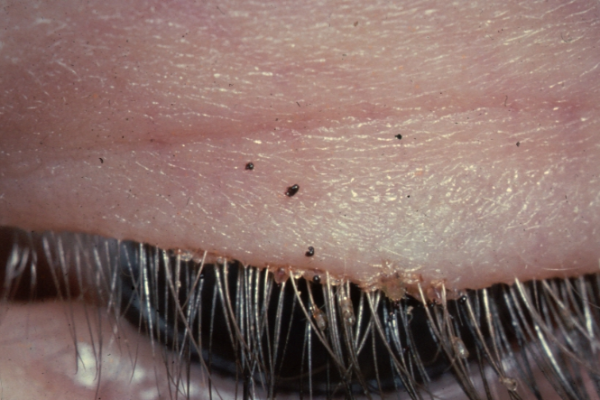Pubic lice
Key points about pubic lice
- Pubic lice (or 'crabs') are tiny insects (parasites) that live in coarse body hair, such as pubic hair.
- They're most commonly spread by sexual contact, and by direct skin-to-skin contact with someone who is infected.
- Itching in your pubic area is the most common symptom.
- Pubic lice infestations don't cause serious harm but can cause a lot of irritation.
- If you have pubic lice, your healthcare provider will want to check for other sexually transmitted infections (STIs) and do a sexual health check.
- Treatment involves using creams, lotion or shampoo containing permethrin.

Pubic lice or 'crabs' are tiny insects (parasites) that live in coarse body hair, such as pubic hair.
Pubic lice infestations are found worldwide. The lice use tiny claws to hang onto hair stands and survive on human blood. They live in pubic hair most commonly but can also live in other coarse human body hair, such as armpit hair, beard hair, chest hair, thigh hair or eyelashes. Interestingly, they don’t live on the hairs on your head (unlike ‘nits’ or head lice). Pubic lice can't survive for 24 hours without feeding off their human host.
The images below show pubic lice in eyelashes and pubic hair.

Image credit: KostaMumcuoglu via Wikimedia Commons(external link)

Image credit: DermNet NZ(external link)
Pubic lice are spread by direct skin-to-skin contact, which most commonly occurs during sexual contact such as if you:
- have vaginal, oral or anal sex with someone who is infected with pubic lice
- kiss or hug someone who has lice in their beard.
You can also get pubic lice when you are in contact with towels, bedding or clothing of someone who is infected with pubic lice, but that is much less common.
Common symptoms of pubic lice include:
- itching in and around your pubic hair area
- faint blue spots in your genital area
- tiny bleeding spots or bite marks between pubic hairs
- skin irritation and redness caused by scratching
- dark brown specks of old blood in your underwear
- lice and eggs may be seen in your pubic hair
- red eyes (if your eyelashes are infected).
Uncommon symptoms include:
- fever, lethargy and irritability (more common in young and frail people)
- secondary bacterial infection.
Some people have no symptoms but they can still spread the parasite to other people.
If you think you have pubic lice or any other sexual health concerns, you can see or talk to your healthcare provider. They will need to look at the affected area for the signs listed above to diagnose pubic lice. There's no specific test available to diagnose them.
If you have pubic lice, your healthcare provider will also check for other STIs and do a sexual health check. Read more about sexually transmitted infections (STIs).
Other places you can get advice or help are:
Sexual health clinics(external link)
Sexual Wellbeing Aotearoa clinics(external link)
Pubic lice are usually treated at home by applying creams, lotion or shampoo containing permethrin to the affected area.
These treatments are available to buy over the counter in pharmacies. In general, the treatment will need to be applied to the affected area (apart from the eyelids and scalp) and washed off after 10 minutes. A second treatment may be needed after 7 days, to kill the remaining lice from eggs that may have survived the first treatment round. Your healthcare provider or pharmacist can advise you on how to use these medicines correctly.
If the lice are not killed by this approach, talk to your healthcare provider or pharmacist to get an alternative treatment.
If your eyelashes are affected, see or talk to your healthcare provider to find out what other medicines can be used. Don't apply medicines with permethrin close to your eye area or to your eyelashes.
Sexual contacts should be examined and treated if necessary.
- Wash your clothing, towels and bedding in hot water at the same time as you are having the treatment. Make sure all your sexual partners are told and are examined by their healthcare provider and treated if necessary.
- Wait to have sex again until 7 days after the first treatment. If you require a second treatment, wait until you've completed that too. Unfortunately, condoms don't protect you from getting pubic lice (although they can protect you from getting other STIs).
The following links provide further information about pubic lice. Be aware that websites from other countries may have information that differs from New Zealand recommendations.
Pubic lice/crabs(external link) Just The Facts, NZ
Pubic lice or crabs(external link) Sexual Wellbeing Aotearoa, NZ
Pubic lice and scabies [PDF, 176 KB] Family Planning Association, UK
Pubic and body lice(external link) Patient Info, UK
References
- Pubic lice/crabs(external link) Just The Facts, NZ
- Pubic lice(external link) DermNet, NZ, 2014
- Pubic lice (crabs)(external link) Better Health Victoria, Australia
- Pubic lice(external link) NHS, UK, 2022
- Pubic and body lice(external link) Patient Info, UK, 2022
- Pubic lice(external link) Centers for Disease Control and Prevention (CDC), US
- STI management guidelines – ectoparasites(external link) New Zealand Sexual Health Society, 2021
STI management guidelines(external link) NZ, 2021
Partner notification/contact tracing guideline(external link) NZ Sexual Health Society, 2017
A “how-to guide” for a sexual health check-up(external link) BPAC, NZ, 2013
Treatment of sexually transmitted and other genital infections(external link) BPAC, NZ, 2009
Credits: Healthify editorial team. Healthify is brought to you by Health Navigator Charitable Trust.
Reviewed by: Katie McCullough, Nurse Practitioner, Clinical Lead, STIEF
Last reviewed:





